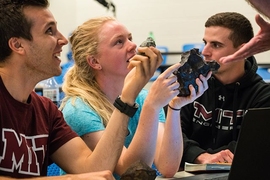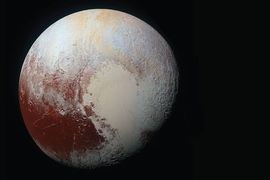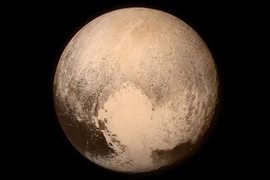After nearly 20 years of planning and 13 years of flight, NASA’s New Horizons spacecraft traveled nearly 6.5 billion kilometers from Earth — the farthest distance yet for a space mission encounter— to visit the Kuiper Belt on the edge of our solar system. In July 2015, the spacecraft approached Pluto, returning extraordinary images and data about the dwarf planet and its moons. Shortly after, the trans-Neptunian object Ultima Thule — whose name means “beyond the known world,” for it is located 1.6 billion kilometers out from Pluto — was selected as the next object of interest. At its closest approach on Jan. 1, the New Horizons probe passed within 3,500 km of 2014 MU69, better known as Ultima Thule, and began transmitting data back to Earth, a process that will take nearly two years to complete. This is the first mission of its kind to explore this region in depth.
New Horizons team members Alissa Earle and Richard Binzel were asked about the significance of the flyby and what it can tell us about the earliest days of our solar system. Earle is a postdoc within the MIT Department of Earth, Atmospheric and Planetary Sciences (EAPS) and on the New Horizons Surface Composition Science Theme Team. Binzel is a co-investigator on the mission, science team liaison for both composition and geology, an EAPS professor of planetary sciences with an appointment in the Department of Aeronautics and Astronautics, a Margaret MacVicar Faculty Fellow, and an expert on asteroids and Pluto.
Q: Why go to the outer reaches of our solar system, including Pluto and other Kuiper belt objects?
A: Earle: Kuiper Belt objects are leftover remnants from when the solar system first formed. By studying them, we hope to gain insight into the history and formation of the solar system. Throughout the late 1980s and early 90s, studies of the Pluto system revealed it was an interesting, complex system, but the small sizes and distance from the sun make these objects difficult to investigate from Earth. The limitations of Earth-based observations generated more questions than they solved. This motivated the New Horizons mission to fly through the Pluto system and Kuiper Belt and study them in a level of detail not possible before.
Now all of the data from the Pluto encounter have been sent back to Earth and undergone initial processing, but we are still working on interpreting it all. The Pluto system is very dynamic and complex, so we are still making sense of all the interesting and unexpected things New Horizons observed during that flyby. The data have revealed a diverse and geologically active world displaying a remarkably broad range of landforms, albedos [surface reflectivity], colors, compositions, and surface processes at play. In addition to the diversity across Pluto’s surface, the system also shows a great deal of diversity when comparing Pluto with its largest moon, Charon, as well as the four smaller satellites in the system.
Binzel: It is a region of our solar system we have never explored, which has experienced very little change in its temperature and chemical conditions over the past 4 billion years, making it completely different from the environment and processes found on Earth. By seeing the extremes of planetary processes across our solar system, we gain a better understanding of our own world.
Here, our realm for understanding how planets in our solar system work has been pushed to new limits. Rather than being a cold and dormant wasteland, we have found the largest Kuiper Belt objects like Pluto to be alive — in the sense that it is a geologically active world. Planetary processes like tectonics, convection, glaciation, haze formation, and possibly volcanism were found to be possible, even at the remote extremes of our solar system.
Q: Why, after the Pluto system, was 2014 MU69 selected as the second object for New Horizons to observe? What makes it so special?
A: Earle: 2014 MU69 was discovered by a survey performed on the Hubble Space Telescope to look for Kuiper Belt objects near the path of New Horizons. Since the spacecraft has a finite fuel supply onboard, we needed to find an object that the spacecraft was able to easily get to. 2014 MU69’s orbit placed it very close to the path of the probe, making it an ideal next target.
Given the diversity of the Pluto system and what we can learn about other Kuiper Belt objects from ground-based observations, it is a pretty safe bet that 2014 MU69 will have its own interesting and unique story to tell. Part of what makes this flyby so exciting is that we know very little about the object, and this time, the spacecraft flew very close to the surface of the object, with an approach distance of less than 2,200 miles, in comparison to 7,800 miles from Pluto. As the name suggests, it was discovered in 2014, so we have only been tracking it from the ground for a few years. Based on occultation measurements [observations of the object as it passes between the observer and a distant star], we learned in advance the object has a very irregular shape unlike Pluto, which is almost a perfect sphere. We also know it is a lot smaller than Pluto, with an estimated diameter of about 25-45 km compared to Pluto’s 2,377 km diameter. We also know it takes almost 300 years for it to orbit the sun.
Binzel: From inception, the New Horizons mission was intended to explore Pluto and the Kuiper Belt. After Pluto, we knew the spacecraft would have limited fuel and limited navigating room. We focused our telescopic searches in that volume of reachable space, expecting to find one or more candidate objects. Indeed, we did with 2014 MU69 being the one most directly on the path and enabling the greatest opportunity for science return.
Compared to Pluto, this flyby was much more focused, in the sense that we are examining one single object. At Pluto, we were studying both the planet and its moon Charon, as well as the full satellite system. This makes the 2014 MU69 flyby much more intense, and for decades to come, 2014 MU69 will be the poster child for what a Kuiper Belt object looks like.
Q: Since the flyby, New Horizons has sent images and data revealing Ultima Thule to have a snowman or bowling pin-like shape. What does this tell us about Ultima Thule and the early solar system?
A: Binzel: Ultima Thule's snowman shape is like a dream come true for how we think the earliest steps of planet formation start. Many small clumps, which we call planetesimals, begin to come together, eventually forming into a large planet like the Earth. However out in the Kuiper Belt, there is not very much material; most of what is left there is remnants of formation that never got very far. The snowman shape is like seeing the first embryo stage of a forming planet that never was able to grow any further. How fascinating to be able to see Ultima Thule as a snapshot of the beginning of our solar system at a time before Earth even existed.
Earle: New Horizons is pioneering the exploration of the Kuiper Belt, the more we learn about the outer reaches of the solar system, the more it can help us learn about its history and provide more context for understanding the rest of the solar system. New Horizons’ flyby of 2014 MU69 provides a detailed look at a small Kuiper Belt object, which provides interesting comparisons with Pluto and its moons, as well as asteroids, which are similar in size but much closer to the sun — and thus warmer and unable to harbor some of the ices that are believed to be common in the Kuiper Belt.
Ground-based observations also proved an important complement for the data being returned from New Horizons. New Horizons is able to take an extremely detailed look at just a handful of objects, whereas ground-based surveys have much less detail but can gather data on more objects to provide context for understanding the New Horizons data and how Pluto, its moons, and 2014 MU69 might compare to other Kuiper Belt objects.
New Horizons is led by the Southwest Research Institute (SwRI) in Boulder, Colorado, and the Johns Hopkins University Applied Physics Laboratory (APL) in Laurel, Maryland. In addition to MIT, APL and SwRI, the New Horizons team includes Stanford University, Ball Aerospace Corp., NASA Goddard Space Flight Center and the Jet Propulsion Laboratory. The mission science team includes expertise from the above institutions, as well as Lowell Observatory, NASA Ames Research Center, Washington University in St. Louis, George Mason University, Johns Hopkins University, and the University of Colorado.











